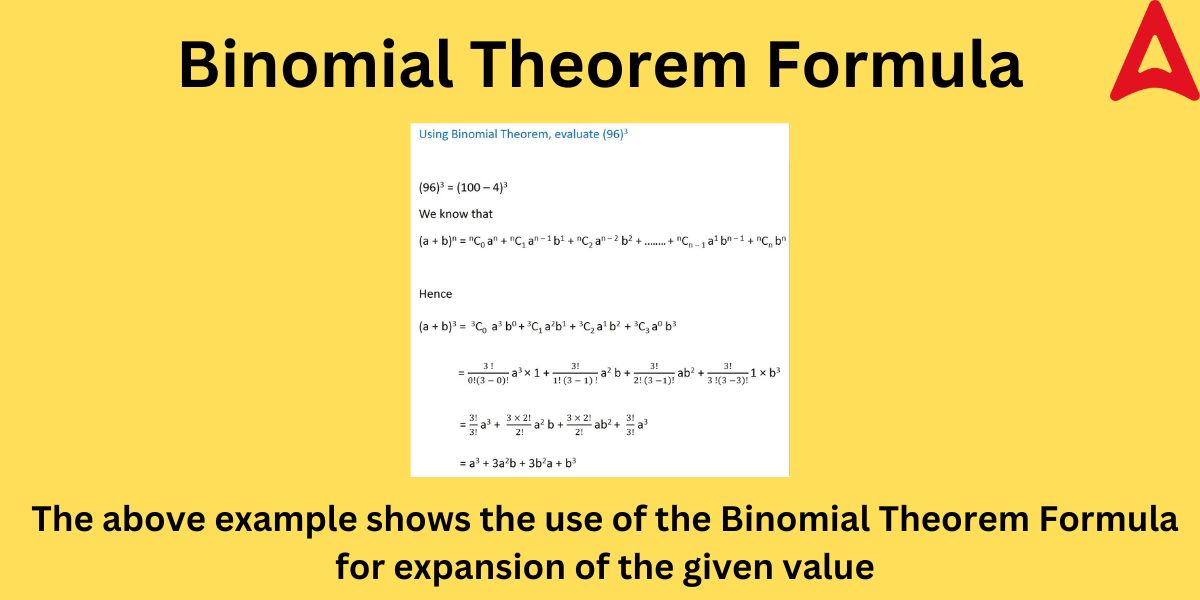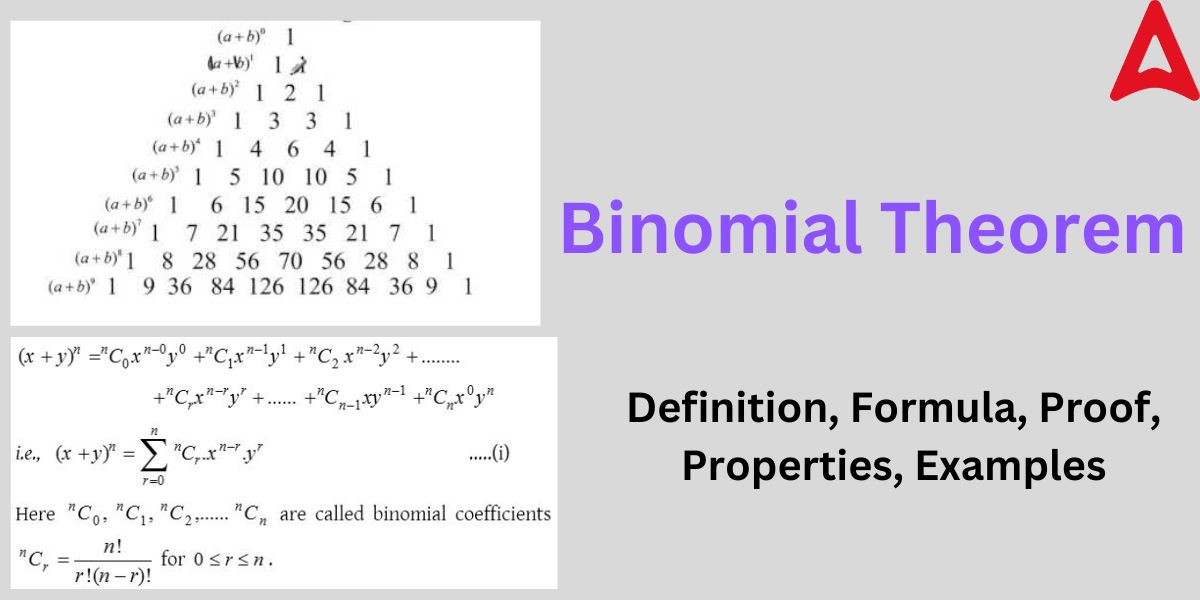Binomial Theorem: Finding the powers of any number or algebraic expression is quite a cumbersome process, especially if the power exceeds the value of 3. We can easily find the power of algebraic expressions up to 2 by using some standard formula. But for higher cases of power, it becomes difficult to operate on such expressions. This is where the Binomial Theorem comes into the picture. The binomial theorem is used for solving complex calculations that include higher power values.
Binomial Theorem
The expansion lengthens and gets difficult to calculate as the power rises. The Binomial Theorem can be used to quickly calculate a binomial expression that has been raised to a very high power. A binomial expression is generally an algebraic expression with two dissimilar terms related to each other via addition or subtraction. For example, a – b, x + y, x² + y², etc. are some of the examples of the binomial expression. In this article, we will dive deep into the various aspects of this special theorem and will also learn about the proof of its formula.
Binomial Theorem Definition
As per the formal mathematical understanding, Binomial theorem is an efficient way of expanding a binomial expression raised to some finite power. It is a fast way of expanding an algebraic expression win the form of (x + y)n. Finding the value for n = 2 or n = 3 may seem easy to calculate due to standardized formula or small calculations, but when the power becomes too large, say n = 12, then it becomes very difficult to find out their value by multiplying out the terms. In this case, this theorem proves to be useful. For example the binomial expression (2x – 9)15, where x = 2x and y = -9, can be easily calculated with the help of this theorem. Let us now learn its formula.
Binomial Theorem Formula
The formula for the binomial theorem helps to find the value of binomial expression raised to certain finite power.
The binomial theorem formula is given by:
(a + b)n =
nCran-rbr
where nCr = n!/(n-r)!r!
where n ∈ N (natural number)
and a, b ∈ R (real number)
It is also known as the binomial theorem general formula.
Binomial Theorem Expansion
The formula for binomial theorem gives us an idea about the expansion of the binomial expression. We can now expand any binomial expression using the formula given above. It is known as the expansion of the binomial expression. That is, if (x + y)n is given to us, then we can write it in the expanded form given below by using the above formula
(x + y)n = nC0 xny0 + nC1 xn-1y1 + nC2 xn-2 y2 + … + nCn-1 x1yn-1 + nCn x0yn. One example of the use of this formula is given in the diagram below.

Binomial Theorem General Term Formula
This formula is used to find the general term of a particular binomial expression. The general term represents each term in the (a + b)n binomial expansion. The formula to find the general term of a binomial expression (a + b)n is given by:
Tr+1 = nCr an-rbr
The r-value in this instance is one less than the term count in the binomial expansion. That is, if we have to find the 10th term, then r-value will be 9, so that T10 can be written as T9+1. The term nCr is known as the coefficient.
Binomial Theorem Middle Term Formula
We can find the middle term of a binomial expression using the formula for this theorem. The expansion of (a + b)n has exactly n + 1 words in total. The value of n affects how the middle term in the binomial expansion is calculated. Whether n is even or odd determines the middle term and how many there are. There is just one middle term for an even value of n, and that term is (n/2 + 1). There are two middle terms for an odd value of n, and those two middle terms are n/2 and (n/2 + 1). Once we know the term number for the middle term, we can find its value by using the general tern formula for the binomial expansion, i.e., Tr+1 = nCr an-rbr, where r = middle term – 1.
Binomial Theorem Formula for Independent Term
We can use the formula for this theorem for finding the term independent of either “p” or “q” in the expansion of the binomial expression (p + q)n. For that, first we find the general term of the expansion using the formula for general term. Then we put the value of r such as the coefficient of the asked variable (either p or q) becomes zero. In this way we can find the independent term in a binomial expression.
For example: To find the term independent of p in the binomial expression (p+q)6
By using the formula for general term Tr+1 = nCr an-rbr
here, a = p and b = q
Tr+1 = nCr pn-rqr
to find the term independent of p, we will have to make its power equal to 0
So, n-r = 0
or, r= n
putting r = n in the general term formula, we get
Tr+1 = nCn pn-nqn
As nCn = 1 and anything raised to power 0 =1
So, Tr+1 = 1 x 1 x qn
Hence, the term independent of p = qn
Binomial Theorem Proof
We can validate the binomial expansion formula by using mathematical Induction rules. The proof for the same is given below.
Suppose there are two variables “a” and “b” in the binomial expression where a, b ∈ R(real numbers)
we have to find its expansion rule for the power value n, where n ∈ N
To prove this theorem using mathematical induction, we will have to prove its validity for n= 1, n= k (k>1) and n= k+1.
For n = 1
It is evident that (a + b)1 = (a + b) by the rule of mathematics.
Hence the equation holds true for n= 1
For n = k, where k is any positive integer with value more than 1
Assuming (a + b)n = ∑nr=0nCr an-rbr,
(a + b)k = ∑kr=0kCr ak-rbr
⇒ (a + b)k = kC0 akb0 + kC1 ak-1b1 + kC2 ak-2 b2 + … + kCr ak-rbr +….+ kCk a0bk
⇒ (a + b)k = ak + kC1 ak-1b1 + kC2 ak-2 b2 + … + kCr ak-rbr +….+ bk
Thus the result is true for n = k > 1.
For n = k+1
Now consider the expansion for n = k + 1.
(a + b) k+1 = (a + b) (a + b)k
= (a + b) (ak + kC1 ak-1b1 + kC2 ak-2 b2 + … + kCr ak-rbr +….+ bk)
= ak+1 + (1 + kC1)akb+ (kC1 + kC2) ak-1b2 + … + (kCr-1 + kCr) ak-r+1br + … + (kCk-1 + 1) abk + bk+1
= ak+1 + k+1C1akb + k+1C2 ak-1b2 + … + k+1Cr ak-r+1br + … + k+1Ck abk + bk+1 [Because nCr + nCr-1 = n+1Cr]
Thus the result is true for n = k+1.
By mathematical induction, this result is true for all positive integers ‘n’ ∈ N.
Hence proved.
Relation Between Binomial Theorem and Pascal’s Triangle
The coefficients of a binomial expansion can be expressed in the form of pascal’s triangle. The binomial coefficients are the terms (numeric value) associated with the variables a, and b in the expansion of binomial expression (a + b)n. The binomial coefficients are present in the expansion as nC0, nC1, nC2, and so on. The coefficient’s values can either by solving them using the combination formula or by using the pascal’s triangle property. Binomial coefficients when arranged in a triangular form, makes a Pascal’s triangle. All of the boundary elements of the numbers in Pascal’s triangle are 1, and the remaining numbers are arranged so that each number is the sum of two numbers directly above it. This property of the coefficients is shown below by forming a pascal’s triangle.

Binomial Expansion for (a + b)-1
We can find the binomial expansion of expressions raised to negative values. The expansion of binomial expression for negative values are often asked in the exam. The binomial expansion for some expressions using the binomial theorem is given below.
(1 + a)-1 = 1 – a + a2 – a3 + a4 – a5 + and so on
(1 + a)-2 = 1 – 2a + 3a2 – 4a3 + and so on
(1 + a)-3 = 1 – 3a + 6a2 – 10a3 + 15a4 + and so on
(1 – a)-1 = 1 + a + a2 + a3 + a4 + a5 + and so on
(1 – a)-2 = 1 + 2a + 3a2 + 4a3 + and so on
(1 – a)-3 = 1 + 3a + 6a2 + 10a3 + 15a4 + and so on
Binomial Theorem Class 11
The Binomial theorem is one of the most important chapters in the NCERT Mathematics syllabus for class 11. This topic in class 11 includes the proof, definition, general term formula, independent term formula, and finding the mid term of a binomial expression. By learning the general formula for binomial theorem and practicing the proof of the formula given above, one can easily prepare this topic for class 11. This article is more than enough to cover all the aspects of the binomial expansion for class 11 students.
Binomial Theorem Properties
Some of the properties related to the binomial theorem is given below:
- In a binomial expansion of power n, there will always be (n+1) number of terms
- The sum of powers of variables in an individual term is always equal to n
- The binomial coefficients equidistant from the starting and end have equal values
Binomial Theorem PDF
Below we have provided the binomial expansion formula for some of the most asked types of expressions. Students will be able to solve questions related to these expressions by going through the PDF provided below.
Binomial Theorem Examples
Some of the solved examples on the topic of Binomial theorem is given below. These examples will help students to understand this topic more clearly.
Example 1: Determine the middle term of the binomial expression (1 + 3a2 –3a – a3)2n
Solution: As 2n is even, so it will have odd number of terms in its expansion and hence, only one middle term.
The given binomial expression can be arranged as (1 – 3a +3a² – a3) which is equal to (a-b)³, where a = 1 and b = a
So, (1 + 3a2 –3a – a3)2n can be written as [(1-a)³]2n
or, (1 – a)6n
So, middle term = (6n/2) +1
or, 6nC3n (−a)3n
Example 2: Find the binomial expansion of (a2 + 1)5 using the binomial theorem formula.
Solution: Using the formula for the binomial expansion given by:
(a + b)n =
nCran-rbr
here, a = a² and b = 1
using these values we expand
(a2 + 1)5 = 5C0 (a2)510 + 5C1 (a2)5-111 + 5C2 (a2)5-2 12 + 5C3 (a2)5-3 13 + 5C4 (a2)5-4 14 + 5C5 (a2)5-5 15
= a10 + 5 a8 + 10 a6 + 10 a4 + 5 a2 + 1
Example 3: Determine the 7th term in the expansion of the binomial expression(a + 4)10
Solution: By using the formula for the general term of a binomial expansion given by:
Tr+1 = nCr an-rbr
T7 = T6+1
so, r = 6, n= 10, a = a, b = 4
on putting these values in the general term equation, we get:
T7 = 10C6 (a)10-6(4)6
or, T7 = 210 x a4 x 4096
Hence, T7 = 860160 a4









 CUET History Syllabus 2026 (Updated), Do...
CUET History Syllabus 2026 (Updated), Do...
 CUET General Test Syllabus 2026 (Latest)...
CUET General Test Syllabus 2026 (Latest)...
 CUET Economics Syllabus 2026, Exam Patte...
CUET Economics Syllabus 2026, Exam Patte...














